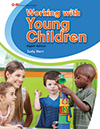Working with Young Children
Unit 1: The Children and You
Chapter 1:
You: Working with Young Children
Chapter 2:
Types of Early Childhood Programs
Chapter 3:
Observing Children: A Tool for Assessment
Chapter 4:
Child Development Principles and Theories
Chapter 5:
Understanding Children from Birth to Age Two
Chapter 6:
Understanding Two- and Three-Year-Olds
Chapter 7:
Understanding Four- and Five-Year-Olds
Chapter 8:
Middle Childhood
Unit 2: Creating a Safe and Healthful Environment
Chapter 9:
Preparing the Environment
Chapter 10:
Selecting Toys, Equipment, and Educational Materials
Chapter 11:
Promoting Children’s Safety
Chapter 12:
Planning Nutritious Meals and Snacks
Chapter 13:
Guiding Children’s Health
Unit 3: Guiding Children
Chapter 14:
Developing Guidance Skills
Chapter 15:
Guidance Challenges
Chapter 16:
Establishing Classroom Limits
Chapter 17:
Handling Daily Routines
Unit 4: Learning Experiences for Children
Chapter 18:
The Curriculum
Chapter 19:
Guiding Art, Blockbuilding, and Sensory Experiences
Chapter 20:
Guiding Storytelling Experiences
Chapter 21:
Guiding Play and Puppetry Experiences
Chapter 22:
Guiding Manuscript Writing Experiences
Chapter 23:
Guiding Math Experiences
Chapter 24:
Guiding Science and Technology Experiences
Chapter 25:
Guiding Social Studies Experiences
Chapter 26:
Guiding Food and Nutrition Experiences
Chapter 27:
Guiding Music and Movement Experiences
Chapter 28:
Guiding Field Trip Experiences
Unit 5: Other People You Will Meet
Chapter 29:
Programs for Infants and Toddlers
Chapter 30:
Programs for School-Age Children
Chapter 31:
Guiding Children with Special Needs
Chapter 32:
Engaging Parents and Families
Chapter 33:
A Career for You in Early Childhood Education
- Copyright © Goodheart-Willcox Co., Inc. All rights reserved.



